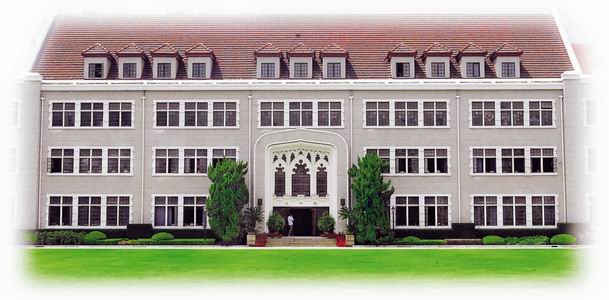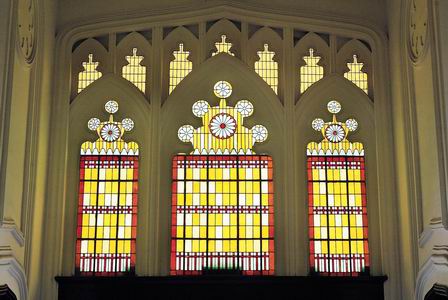Shanghai Daily news

The main building of Shanghai No.3 Girls¡¯ Middle School
on Jiangsu Road. The building was designed by Hungarian-born architect
Ladislau Hudec in the 1930s for the former McTyeire School.(Photo: Shanghai
Daily)

The school¡¯s original stained-glass windows remain
intact.(Photo: Shanghai Daily)
In the early 20th century, the McTyeire School educated the elite young
ladies of Shanghai. Tina Kanagaratnam steps into the hallowed halls of the
school that is today the No. 3 Girls¡¯ Middle School.
Young women in smart uniforms run down the wide steps, ponytails flying,
laughing and talking. Clusters of girls sit and chat on the green lawn that
fronts the grey, castle-inspired structure. They are just like any other
adolescent girl ¡ª but there is something different about them. These girls, the
girls of the Shanghai No. 3 Girls¡¯ Middle School have a poise, confidence and
ambition unusual for young women of their age ¡ª but familiar to those who know
the products of posh girls¡¯ schools anywhere.
For despite its rather
egalitarian name, that is exactly what the No. 3 Girls¡¯ Middle School is ¡ª and
what it has always been. It was in 1890 that the Southern Methodist Mission
decided to set up the McTyeire School for Chinese girls in Shanghai. Education
was in English, teachers were foreign, and the outlook was decidedly Western.
It was a radical idea for its time: the benefits of education were
considered unnecessary for girls (who would, after all, be leaving their
families to marry). Better that they learn to sew a fine seam and cultivate the
qualities that would ensure that they married well.
Although it was not the
first school for girls in China ¡ª that honor went to a school in Ningbo in
neighboring Zhejiang Province, set up by a priest in 1844 ¡ª the idea was
sufficiently extreme that that first class contained only five girls.
The
McTyeire School was named for Bishop Holland McTyeire, the Tennessee-based head
of the Southern Methodist Mission. McTyeire was a big name in the Southern
Methodist world ¡ª he had been instrumental in founding Vanderbilt University in
Nashville, Tennessee, and served as the university¡¯s chancellor. More
interesting, though, is his Shanghai connection.
In 1882, he met a young man
from China named Charlie Soong, who would later become famous as the father of
the legendary Soong sisters. At the age of nine, Soong had gone to America from
Hainan in South China with his uncle ¡ª the first "tea-and-silk¡± Chinese merchant
to emigrate to the US ¡ª to work in his uncle¡¯s Boston shop.
There, while
working behind the counter, he met two young Chinese students who had come to
America as part of the Chinese Educational Mission, brainchild of educational
pioneer (and Yale graduate) Yung Wing. The students, Wan Bing-chung and New
Shanchow, convinced young Soong that he should be getting an education instead
of selling tea ¡ª but Soong¡¯s traditional family did not agree, and so he ran
away, stowing away on a ship. Through a captain he met on that ship Soong
eventually ended up at the School of Religion at Vanderbilt.
It was Bishop
McTyeire who allowed Soong to be ordained in 1885, when Chinese were not
permitted to be ordained. Soong returned to China ¡ª to Shanghai, in 1886 ¡ª where
he married and would eventually have three daughters, the fabled Soong sisters
(all of whom would attend McTyeire) as well as three sons.
Education in
China in the early 20th century was inseparable from the social foment and
formation of modern China that was going on. Prestigious schools such as
McTyeire created a new kind of elite, people who fostered community, national
spirit ¡ª and, as Heidi Ross points out in her chapter on McTyeire in ¡°Social
Engineering and the Social Sciences in China, 1919-1949¡± by Yung-chen Chiang,
¡°service toward the public good.¡±
The McTyeire School was originally located
on Hankou Road, near what is today the Methodist Moore Memorial Church, where
Charlie Soong was the head of the Sunday school.
It was the Hankou Road
school that Charlie Soong¡¯s eldest daughter, Soong Ai Ling, attended McTyeire,
when she insisted at age five that she be allowed to go to school. The other
pupils were considerably older, but Ai Ling was tutored by the headmistress,
Helen Richardson, and ¡°became the mascot of the school,¡± according to Emily
Hahn, in her biography ¡°The Soong Sisters.¡±
Her two sisters ¡ª Soong Ching
Ling, who married Dr Sun Yat-sen, founder of the Republic of China, and Soong
Mei Ling, who married Chiang Kai-shek, the former Taiwan leader ¡ª followed her
to McTyeire, but none made as much of an impression as the precocious Ai Ling.
By the 1930s, McTyeire had moved to more spacious grounds on Edinburgh Road,
and hired the firm of R.A. Curry to construct their new buildings. It was a
young architect, freshly arrived from Hungary, who designed the buildings:
Ladislau Hudec, perhaps old Shanghai¡¯s most gifted architect.
Fortunately,
much of the McTyeire that Hudec built is still intact. The main building ¡ª what
was called Richardson Hall, after Helen Richardson, until 1949 ¡ª faces a
beautiful green sward, where the young ladies still gather to chat and play
sports. Inside, the stained glass in the lobby is miraculously intact, as is the
old, atmospheric theater. Wandering the halls today cannot feel enormously
different to how it felt half a century ago.
The 1938 ¡°McTyeiren¡± ¡ª the
yearbook ¡ª offers up a snapshot of McTyeire life in old Shanghai. The yearbook
itself is bilingual, and the senior portraits depict freshfaced young ladies,
dressed in qipao, with bright, intelligent eyes staring across the years.
Some are ¡°always cheerful, modest and accomplished,¡± others are ¡°a perfect
woman, nobly planned,¡± still others ¡°a talented girl, a bright student.¡± They
played basketball, hockey and baseball, acted in the ¡°Merchant of Venice¡± and
¡°Miss Yu¡¯s Secret;¡± they wrote poems and sang the McTyeire School song:
¡°Near the mighty Yangtze River,
In the heart of old Shanghai,
There¡¯s
a school for China¡¯s daughters
Bringing truth and freedom nigh.
May she
live and grow forever,
Scatter knowledge far and near.
Till all China
learns the lessons
That we learn at old McTyeire."
And like all old
schools,
McTyeire was full of traditions: the senior class hands down its
colors to junior class 2; a class tree is planted; emotional
dedications are
made in the yearbook.
McTyeire ceased to exist after 1949, but it has
remained an elite girls¡¯ school (except for a brief period during the ¡°cultural
revolution¡± from 1966 to 1976 when it went coed). Today the No. 3 Girls¡¯Middle
School is a city¡¯s ¡°key¡±
school, one that still sends almost all its
graduates to university.
But some things haven¡¯t changed: the school
buildings are still the same, the girls still stand on the steps of Richardson
Hall, and on warm spring days, the girls of the No. 3 Girls¡¯ Middle School still
play baseball.



